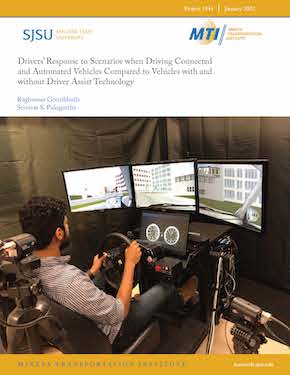- 408-924-7560
- mineta-institute@sjsu.edu
- Donate
Drivers’ Response to Scenarios when Driving Connected and Automated Vehicles Compared to Vehicles with and without Driver Assist Technology
Traffic related crashes cause more than 38,000 fatalities every year in the United States. They are the leading cause of death among drivers up to 54 years in age and incur $871 million in losses each year. Driver errors contribute to about 94% of these crashes. In response, automotive companies have been developing vehicles with advanced driver assistance systems (ADAS) that aid in various driving tasks. These features are aimed at enhancing safety by either warning drivers of a potential hazard or picking up certain driving maneuvers like maintaining the lane. These features are already part of vehicles with Driver Assistance Technology, and they are vital for successful deployment of connected and automated vehicles in the near future. However, drivers' responses to driving vehicles with advanced features have been meagerly explored. This research evaluates driver participants' response to scenarios when driving connected and automated vehicles compared to vehicles with and without Driver Assistance Technology. The research developed rural, urban, and freeway driving scenarios in a driver simulator and tested on participants sixteen years to sixty-five years old. The research team explored two types of advanced features by categorizing them into warnings and automated features. The results show that the advanced features affected driving behavior by making driver participants less aggressive and harmonizing the driving environment. This research also discovered that the type of driving scenario influences the effect of advanced features on driver behavior. Additionally, aggressive driving behavior was observed most in male participants and during nighttime conditions. Rainy conditions and female participants were associated with less aggressive driving behavior. The findings from this research help to assess driver behavior when driving vehicles with advanced features. They can be inputted into microsimulation software to model the effect of vehicles with advanced features on the performance of transportation systems, advancing technology that could eventually save millions of dollars and thousands of lives.
RAGHUVEER GOURIBHATLA
Mr. Raghuveer Gouribhatla is pursuing his PhD in the Infrastructure and Environmental Systems (INES) program at the University of North Carolina at Charlotte, where he earned his Master’s degree in Transportation Engineering. His areas of interest are traffic safety, connected and automated vehicles, transit systems, and traffic operations.
SRINIVAS S. PULUGURTHA
Dr. Srinivas S. Pulugurtha, PE, F.ASCE is currently working as a Professor & Research Director of the Department of Civil and Environmental Engineering at the University of North Carolina at Charlotte. He is also the Director of the Infrastructure, Design, Environment, and Sustainability (IDEAS) Center at the University of North Carolina at Charlotte.
-
Contact Us
San José State University One Washington Square, San Jose, CA 95192 Phone: 408-924-7560 Email: mineta-institute@sjsu.edu






